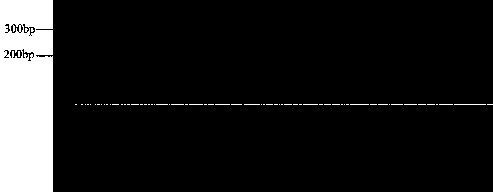Molecular marker closely linked to peach weeping gene and application of molecular marker
A molecular marker and weeping technology, which is applied in the determination/inspection of microorganisms, DNA/RNA fragments, recombinant DNA technology, etc., can solve the problems of large genetic distance and difficulty in realizing the molecular identification of peach weeping traits, and achieves simple and convenient methods. Good application promotion prospect, less restrictive effect
- Summary
- Abstract
- Description
- Claims
- Application Information
AI Technical Summary
Problems solved by technology
Method used
Image
Examples
Embodiment 1
[0039] Example 1: Identification of weeping branch phenotypes in hybrid segregation populations
[0040] According to the uprightness and degree of weeping branches of peach tree branches, phenotypic evaluation is carried out, wherein the new slightly drooping branches are like weeping willows, which are weeping branches, such as figure 1 Shown; the new branch grows slightly negatively upwards as a common type, such as figure 2 shown.
[0041] "Xinxiang 144" was used as the parent to self-cross, and 152 seedlings of the self-crossed offspring were obtained, and the phenotype evaluation was carried out in April 2016 after planting.
[0042] Through the phenotypic evaluation of the offspring individual plants, it was found that 96 common plants and 56 weeping plants were found. The ratio of the two was close to 3:1, and the P value was 0.700, which conformed to the Mendelian inheritance law, and the weeping traits were controlled by a recessive single gene.
Embodiment 2
[0043] Embodiment two: the extraction of genomic DNA
[0044] Using the CTAB method to extract the genomic DNA of peach leaves, the specific steps are as follows:
[0045] (1) Take about 30 mg of young peach leaves, put them into a 1.2 mL eight-row centrifuge tube, add a 5 mm steel ball to each well, put them into a 96-well base, and freeze them fully with liquid nitrogen;
[0046] (2) Manually shake it several times to ensure that the steel balls fully break the sample, and then grind it with a DNA automatic grinder (Shanghai Lingcheng Biotechnology Co., Ltd.), with a frequency of 30 Hz and a time of 90 s;
[0047] (3) Add 600 μL of the prepared CTAB solution with a 300 mL range 8-channel pipette, put it in a 60°C electric constant temperature blast drying oven and heat for 30 min, during which, shake gently every 10 min;
[0048] (4) Place in a refrigerated centrifuge (Eppendorf 5810 R) at 4°C and centrifuge at 4000 rpm; add a mixture of chloroform and isoamyl alcohol at a ...
Embodiment 3
[0052] Example 3: Primer Design for SNP Development
[0053] Refer to the peach genome sequence (Genome Database for Rosaceae PeachVersion 2.0), and use Primer 3 Input (version4.0) (http: / / primer3.ut.ee / ) to design primers. The length of the primers was 20-25 bp. The SNP markers based on Sanger sequencing were developed, and a pair of primers were designed for every 1 Mb. The length of the amplified fragment was about 700-1600 bp.
[0054] Detailed primer information is shown in Table 1:
[0055] Table 1 Primer information using closely linked SNP markers
[0056] .
PUM
 Login to View More
Login to View More Abstract
Description
Claims
Application Information
 Login to View More
Login to View More - R&D
- Intellectual Property
- Life Sciences
- Materials
- Tech Scout
- Unparalleled Data Quality
- Higher Quality Content
- 60% Fewer Hallucinations
Browse by: Latest US Patents, China's latest patents, Technical Efficacy Thesaurus, Application Domain, Technology Topic, Popular Technical Reports.
© 2025 PatSnap. All rights reserved.Legal|Privacy policy|Modern Slavery Act Transparency Statement|Sitemap|About US| Contact US: help@patsnap.com



